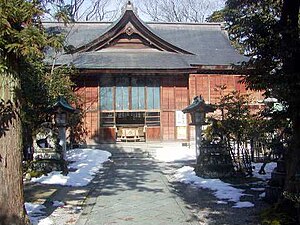Onominato Shrine
Script error: No such module "Draft topics".
Script error: No such module "AfC topic".
| Onominato Shrine | |
|---|---|
 | |
| Religion | |
| Affiliation | Shinto |
Onominato Shrine is a Beppyo shrine in Kanazawa, Ishikawa Prefecture.-platinumapsjp-platinumaps-2023a-1|[1]
History[edit]
According to Japanese mythology Sarutahiko Okami, the main god of the shrine, was discovered in the sea during a voyage by an individual named Sana from Mutsu Province in the year 727. Upon enshrining the deity in the gold stone Masagoyama pole forest, it was bestowed the name "Sanatake Daimeijin."-platinumapsjp-platinumaps-2023a-1|[1]
The shrine was originally on a beach, but the shrine was moved to its present site in 1252 following a fire that destroyed the original structure.-platinumapsjp-platinumaps-2023a-1|[1]
The shrine faced destruction again during the turmoil of the Ikko-ikki rebellions. It was restored by Toshiie Maeda in 1586. Later, in 1639, Maeda Toshitsune, the third feudal lord, constructed three primary shrines within its precincts.-platinumapsjp-platinumaps-2023a-1|[1]
In 1872, it became a village shrine and subsequently gained reverence in 22 neighboring towns, including Kanaiwa Town. By 1879, it received the status of a prefectural shrine. Presently, it stands as an individual shrine affiliated with the Association of Shinto Shrines.-platinumapsjp-platinumaps-2023a-1|[1]

Subshrines[edit]
Hachiman Shrine: Enshrines Hachiman also known as Emperor Ojin.-platinumapsjp-platinumaps-2023a-1|[1]
Shinmei Shrine: Situated to the right, this shrine is dedicated to Amaterasu Okami.-platinumapsjp-platinumaps-2023a-1|[1]
Sanabu Shrine: Positioned to the left, it venerates the Okami of Sanatake, Sarutahiko Okami.-platinumapsjp-platinumaps-2023a-1|[1]
Cultural property[edit]
In 1982, the three main shrines of Onominato Shrine were declared cultural assets of Ishikawa Prefecture. -platinumapsjp-platinumaps-2023a-1|[1]
The Chinju no Mori of the shrine, and its older worship hall, along with various documents, are recognized as cultural properties. -platinumapsjp-platinumaps-2023a-1|[1]
The Shinto ritual Noh, emblematic of Kanazawa's traditional culture, has been staged more than 400 times since 1604. The shrine's summer festival stands out in Kanazawa for its magnitude and splendor, and has been labeled an intangible folk cultural asset of Kanazawa City.-platinumapsjp-platinumaps-2023a-1|[1] Maeda Toshiie promoted Noh, and his son revived its practice at this shrine.[2]
References[edit]
- ↑ -platinumapsjp-platinumaps-2023a_1-0|1.00 -platinumapsjp-platinumaps-2023a_1-1|1.01 -platinumapsjp-platinumaps-2023a_1-2|1.02 -platinumapsjp-platinumaps-2023a_1-3|1.03 -platinumapsjp-platinumaps-2023a_1-4|1.04 -platinumapsjp-platinumaps-2023a_1-5|1.05 -platinumapsjp-platinumaps-2023a_1-6|1.06 -platinumapsjp-platinumaps-2023a_1-7|1.07 -platinumapsjp-platinumaps-2023a_1-8|1.08 -platinumapsjp-platinumaps-2023a_1-9|1.09 -platinumapsjp-platinumaps-2023a_1-10|1.10 "Onominato Shrine - 金沢市観光デジタルマップ | プラチナマップ". プラチナマップ | platinumaps.jp - Platinumaps. Retrieved 2023-10-18.
- ↑ https://www.city.kanazawa.ishikawa.jp/f-living/english/KanazawaTradCulture_EN.pdf
This article "Onominato Shrine" is from Wikipedia. The list of its authors can be seen in its historical and/or the page Edithistory:Onominato Shrine. Articles copied from Draft Namespace on Wikipedia could be seen on the Draft Namespace of Wikipedia and not main one.
